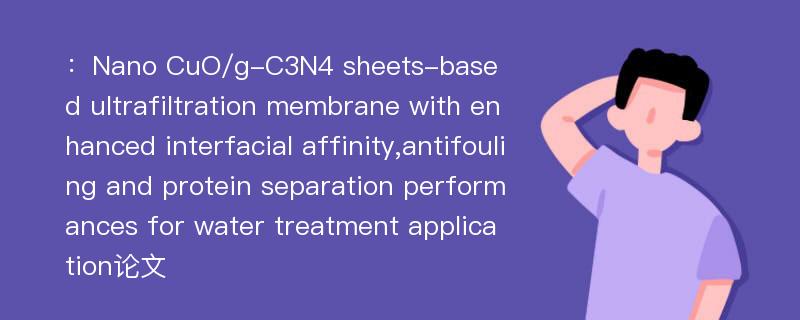
本文主要研究内容
作者(2019)在《Nano CuO/g-C3N4 sheets-based ultrafiltration membrane with enhanced interfacial affinity,antifouling and protein separation performances for water treatment application》一文中研究指出:To improve the interfacial affinity and antifouling properties of polyphenylsulfone(PPSU)membrane, nano CuO/g-C3 N4(g-CN) sheets were synthesized via facile calcination route as one pot synthesis method. The uniformly assembled nanohybrid fillers, CuO on g-CN sheets were confirmed by using XRD, TEM, EDX and FTIR analysis. The non-solvent induced phase inversion technique was used to fabricate the nanohybrid ultrafiltration(UF)membranes by doping different concentration(0.5–1 wt.%) of nano CuO/g-C3N4(g-CN)sheets within the PPSU matrix. The results of contact angle, atomic force microscopy,energy-dispersive X-ray spectroscopy reveal that surface structure and physico-chemical properties of nanohybrid membrane plays lead role in solute interaction and rejection compared to bare membrane, M0. Furthermore, the interfacial affinity of membrane was explored in detail via surface free energy, spreading coefficient, wetting tension and reversible work of adhesion analysis. Nanohybrid UF membrane, with 0.5% of the filler(M1)displayed remarkable permeation flux of 202, 131 L/m2/hr for pure water and protein solution, respectively while maintaining a high protein rejection(96%). Moreover, the exceptional dispersion of the nanosheets in the polymer matrix enhanced FRR(79%) and decreased the overall resistance of M1 compared to the pristine membrane(M0). Overall results suggest that the incorporation of nano sheets is a facile modification technique which improves the comprehensive membrane performance and holds a great potential to be further explored for water treatment.
Abstract
To improve the interfacial affinity and antifouling properties of polyphenylsulfone(PPSU)membrane, nano CuO/g-C3 N4(g-CN) sheets were synthesized via facile calcination route as one pot synthesis method. The uniformly assembled nanohybrid fillers, CuO on g-CN sheets were confirmed by using XRD, TEM, EDX and FTIR analysis. The non-solvent induced phase inversion technique was used to fabricate the nanohybrid ultrafiltration(UF)membranes by doping different concentration(0.5–1 wt.%) of nano CuO/g-C3N4(g-CN)sheets within the PPSU matrix. The results of contact angle, atomic force microscopy,energy-dispersive X-ray spectroscopy reveal that surface structure and physico-chemical properties of nanohybrid membrane plays lead role in solute interaction and rejection compared to bare membrane, M0. Furthermore, the interfacial affinity of membrane was explored in detail via surface free energy, spreading coefficient, wetting tension and reversible work of adhesion analysis. Nanohybrid UF membrane, with 0.5% of the filler(M1)displayed remarkable permeation flux of 202, 131 L/m2/hr for pure water and protein solution, respectively while maintaining a high protein rejection(96%). Moreover, the exceptional dispersion of the nanosheets in the polymer matrix enhanced FRR(79%) and decreased the overall resistance of M1 compared to the pristine membrane(M0). Overall results suggest that the incorporation of nano sheets is a facile modification technique which improves the comprehensive membrane performance and holds a great potential to be further explored for water treatment.
论文参考文献
论文详细介绍
论文作者分别是来自Journal of Environmental Sciences的,发表于刊物Journal of Environmental Sciences2019年08期论文,是一篇关于,Journal of Environmental Sciences2019年08期论文的文章。本文可供学术参考使用,各位学者可以免费参考阅读下载,文章观点不代表本站观点,资料来自Journal of Environmental Sciences2019年08期论文网站,若本站收录的文献无意侵犯了您的著作版权,请联系我们删除。
